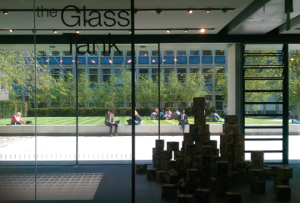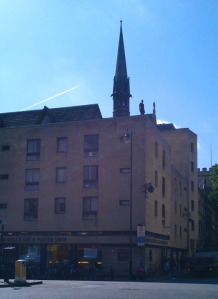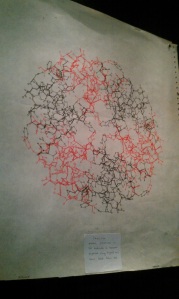A Day in Oxford: Oxford University Weston Library and ARLIS visit to Oxford Brookes Headington Library
Oxford is one of my favourite places in the whole world; I adore the fascinating museums, the amazing architecture, the beautiful parks, and of course, experiencing that constant air of energy that can only be found in places where learning, exploration and discovery are at the very heart of their existence.
 The opportunity to visit two of the power houses driving this energy arose in the form of a recent ARLIS visit to Oxford Brookes University’s Headington Library and ‘Glass Tank’ exhibition space, both of which are situated within the architecturally cutting edge John Henry Brookes Building, alongside a visit to the eagerly anticipated Oxford University Weston Library, displaying many of its archive treasures.
The opportunity to visit two of the power houses driving this energy arose in the form of a recent ARLIS visit to Oxford Brookes University’s Headington Library and ‘Glass Tank’ exhibition space, both of which are situated within the architecturally cutting edge John Henry Brookes Building, alongside a visit to the eagerly anticipated Oxford University Weston Library, displaying many of its archive treasures.
Inspired further by WSA libraries’ own imminent redevelopment which includes some new exhibition display spaces, it was with great delight that I travelled to Oxford with the intention of visiting these contrasting yet complementary libraries in anticipation of innovative examples of museum and library crossovers .
My first visit was to the new Weston library located at the heart of the city situated on the famous Broad Street which, I recently discovered, is overlooked by one of Antony Gormley’s ‘Iron Man’ sculptures from the series entitled Another Time (XI). The Iron Man can be spotted gazing down upon the street with his enviable view from atop the highly recommended Blackwell’s art bookshop.
The Weston Library, formally known as the New Bodleian library opened after a £80 million renovation for the first time in March this year. It was designed to balance the pragmatic requirements of the ever expanding stock, the needs of the users and the conservation needs of the collection which included some of the most important but fragile items of significance to all mankind.
From inception the Weston Library had intended to include, amongst other cutting edge features, a state of the art exhibition space through which Oxford University could promote their collections and engage participation of the wider community with them more effectively. Demonstrating their commitment to this endeavour, a poll was held via social media in 2011 alongside the exhibition ‘Treasures of the Bodleian’ for the public to vote on and decide what they considered a treasure. This subjective interpretation by the public was then used as a basis for how items included in future exhibitions of the new space.
The opening exhibition ‘Marks of Genius’ explores the meaning of genius as a human attribute, and documents the lives of those exceptional individuals that passed though Oxford University and were influenced by their experience of Oxford on their journeys. The exhibition also touches on the role of Oxford University as one of the country’s legal repositories of books, explaining why they have so much amazing stuff with room for expansion.
Amongst the fabulous wealth of well illuminated items on display are some really well known items such as Shakespeare’s first Folio of Hamlet and first edition Jane Austen books and examples of her original drafts. Other not so famous but equally interesting items included beautifully designed and printed William Morris books and a fantastic hand drawing of the structure of insulin by the biochemist Dorothy Hodgkin who won the Nobel prize for chemistry in 1964. Ephemeral poster and leaflet collections from the history of Oxford and an intriguing pirated copy of Galileo’s Sidereus nuncius (The Starry Messenger) dated to 1610, illustrating how copyright infringement is by no means a new phenomenon, also made for some of the more unusual items included in the exhibition.
The remaining public access space is lovely and successfully aligns the feel of the Bodleian. From the entrance the book stacks can be seen through transparent glass and there is also the inclusion of a smaller exhibition space for holding more temporary exhibitions which currently displays 3 copies of Magna Carta belonging to the Bodleian along with other related significant documents to coincide with the 800 year anniversary celebrations. Other items such as a replica old printing press used for demonstrations and a magnificent 17th century cartographic tapestry are situated here as well as social space in the form of a nice café.
 Further down the road however, at Oxford Brooks’ Headington campus was a library with a completely contrasting identity, but none the less impressive. The John Henry Brookes Building is at the cutting edge of architectural design which integrates the Headington library along with multiple community and social orientated spaces including a gallery, Students’ Union and outdoor space resembling a small commercial space.
Further down the road however, at Oxford Brooks’ Headington campus was a library with a completely contrasting identity, but none the less impressive. The John Henry Brookes Building is at the cutting edge of architectural design which integrates the Headington library along with multiple community and social orientated spaces including a gallery, Students’ Union and outdoor space resembling a small commercial space.
Constructed in 2011 and costing £132 million, this building is intelligent and also has the ability to regulate a homeostatic state in addition to fluidly incorporating many spaces of varied use, for which it has won several architectural awards.
The library is a central feature of the building and recognisable by its hot pink color scheme. Each space within the library is designed to accommodate different types of learning simultaneously. Private silent space is accompanied by fantastic serene views of the greenery around Oxford whilst a more informal space perched on top of a floating wooden exterior lecture theatre includes enclosed seating hubs along with screens for group working. The students looked very comfortable indeed in their surroundings.
Below and opposite the library is the central Forum. This was a highly sociable space that was being used by many community members as well as the students; from mums feeding their babies to book groups meeting for a review, it felt like an extremely successful and integrated space. What really brought this together though is the inclusion of an art installation entitled ‘Resounding’ made by Glaswegian artist Annie Cattrell which was suspended in the very centre of all this space.
“This visual and physical behaviour of water is intended to act as a subtle metaphor for how teaching and learning can extend and reverberate knowledge and ideas beyond university”. – Annie Cattrell: https://www.brookes.ac.uk/about-brookes/news/resounding-public-art-installed-in-john-henry-brookes-building/
The library also has its own vast set of special collections, a selection of which includes: Artists’ Books, the Food and Drink library with sections such as the Ken Hom Library and a personal favorite, the National Brewing library, Oxford Brookes University archive, Oxford’s Museum of Modern Art archive and publishing and literary prizes archives. These rich and varied resources would be of particular interest to art and graphic design students and clearly made a direct contribution to those undertaking arts based courses there.
Finally, we were shown to the ‘Glass Tank’ exhibition space which was being used to host part of the Oxford Brookes fine art degree show as well as their 150th anniversary celebrations. Again, these spaces were airy, lovely and engaging and illustrated well how adaptable a dedicated space could be by holding a very conceptual display alongside a more archival based one, and how the use of special collections for students of art and a more general engagement of the public could be achieved.
It was a privilege to experience such differing libraries aiming to achieve the engagement of all via their collections in new ways but making it personal, fitting their own identity needs throughout the process. I came away from the day very much with a feeling of advocacy for the integration of, or certainly for closer working between museums, archives and libraries in the future. If you are around Oxford this summer I would highly recommend a visit to either, or both of these wonderful libraries as they do not disappoint.
‘Marks of Genius’ is free and open from 21st March – 20th September 2015. If you are unable to visit, many items are available digitally here.
Our Museum Studies section can be found at 069 in Library 1 and resources in our Artists Books at 741.64. Please note our Special Collections are by appointment, which you can book by emailing wsaenqs@soton.ac.uk
June 2015




